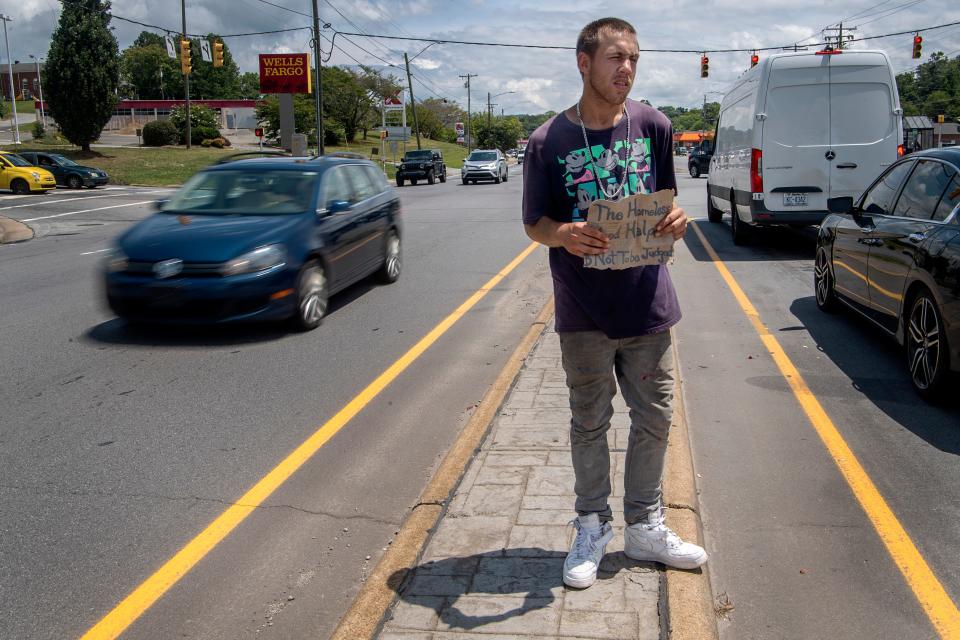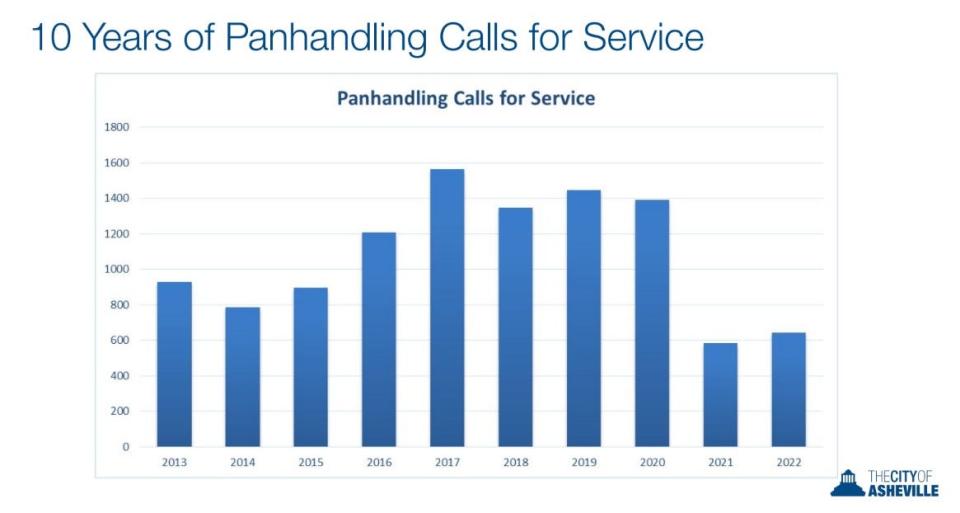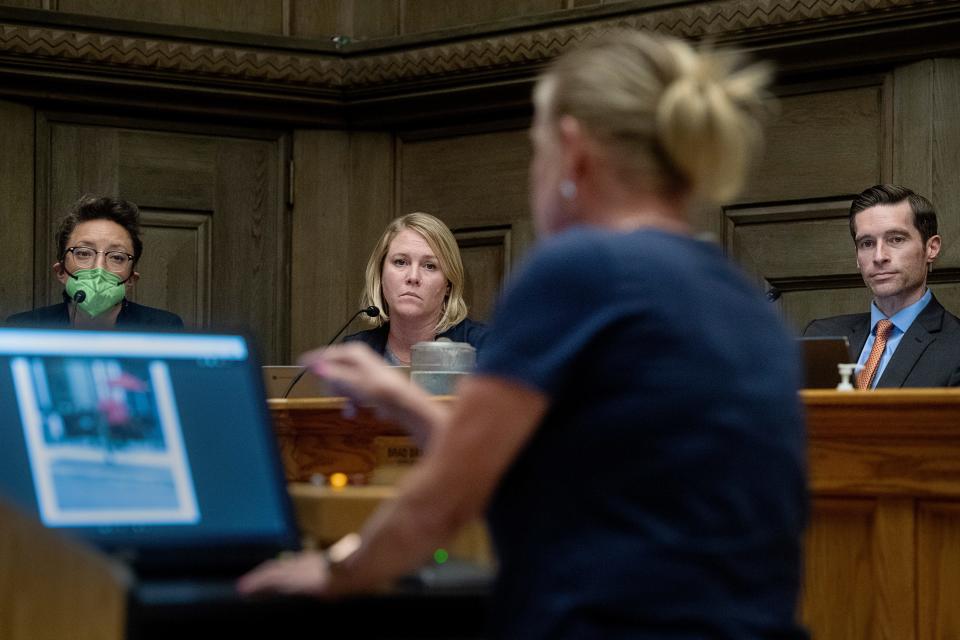Asheville pauses further panhandling restrictions; data shows calls fell in last 3 years
ASHEVILLE — After several months of intense city discussion, public debate and a downtown safety initiative, which was meant to ― in part ― cut down on a perceived rise in panhandling, the city will pause on further panhandling restrictions and shift to analyzing data on the effects of recently passed “technical” amendments, which were approved after a second reading by Asheville City Council Sept. 12.
That’s according to a Sept. 26 Environment and Safety Committee meeting, which was an “information only” meeting regarding updates on various projects and plans, including next steps for the city’s panhandling ordinance.
At the meeting, Asheville Police Department Deputy Chief Mike Lamb presented data showing that panhandling calls for service have actually decreased over the past three years. He said over the last 10 years, APD received a total of 11,000 calls for service regarding panhandling, peaking in 2017 with close to 1,600 calls.

Read more on the specific updates here: Asheville council passes panhandling amendments; ban on vehicle donations to be considered
In 2020, APD received just under 1,400 calls for service, but those dropped by more than 57% in 2021 with fewer than 600 calls regarding panhandling in 2021 and just over 600 in 2022.
Lamb attributed this decline to underreporting, saying that the drop was around summer of 2020 when APD announced it would stop responding to certain calls including those for panhandling, citing the department’s declining staff.
“It is important to note that at this time, staff is not recommending any additional rules, regulation or council action,” City Attorney Brad Branham stated in the meeting. “That includes no recommendation on additional rules on roadside panhandling or vehicular donations.”
The Asheville Police Department is collecting data, Branham said, to analyze the effectiveness of the recent amendments, pinpoint trends and “see if any additional legislative action would be necessary.”
The council-approved changes to the non-solicitation ordinance have been billed as “technical amendments” to help clarify rules regarding solicitation for panhandlers, the public and law enforcement officials. Branham has previously said that these updates to Asheville City Code sections 11-5 and 11-14, which went untouched for two decades, were intended to “create specificity” and bring the code into compliance with recent U.S. Supreme Court rulings.
More: Answer Man: Has the Asheville Police Department been defunded? We break down the numbers

Lamb said that over the next few months, staff will collect and analyze data to determine the possible extension of areas designated as “high traffic zones,” which require panhandlers to follow additional regulations such as holding signs instead of verbally asking for help, staying on the sidewalk and not soliciting after dark.
“Staff will assist in the recommended locations and compare with current high-traffic zones, as well as other areas across the city,” Lamb said. “Areas considered will be assessed based on pedestrian crashes, commercial development, and then lastly calls for service.”
Current high-traffic zones encompass Biltmore Village Historic District and a large portion of downtown, though based on data already collected and presented in the Sept. 26 meeting, Lamb said the committee may want to consider adding Haywood Road in West Asheville, the River Arts District, as well as expanding certain high traffic areas around downtown.
“Most pedestrian crashes within the central business district have occurred near high traffic intersections with some limited correlation to panhandling,” Lamb said. “It may be suggested to extend Zone One (the downtown high traffic zone) boundary north into that Merriman Avenue area where you see the 149 calls for service.”
What are next steps?
The meeting featured some discussion by committee members on whether using staff time to conduct further research on this ordinance is the best use of department resources, and what the pause in further legislative action really means.
“Knowing that staff time is a scarce resource in the police department, I kind of wonder, what is the highest and best use of doing data and analysis to look at policy adjustments?” Councilmember Maggie Ullman said.
“I think that the update, the non-substantive one, that we did in September makes sense, and I think that’s progress on behalf of the community,” Ullman continued. “But I have a little bit of hesitancy to feel excited about continuing to research this particular policy area without knowing what the other things are that we could be working on, because we haven’t had that conversation as a committee.”

Lamb assured the committee that continuing this research won’t take additional staff time because it’s data that APD already collects, given that officers already make incident reports and accident reports regarding panhandling calls for service. He said as far as officer resources, it's “pretty much business as usual.”
Regarding the pause in further rule changes, councilmember Sheneika Smith asked the group to define what the pause means, acknowledging that this issue has received much attention and scrutiny.
“My pause is not stepping back because of pressure,” Smith said. “My pause is taking a step back so that we can make the right moves and make sure everyone is safe.”
City Manager Debra Campbell responded, saying “that is exactly what is motivating us.” She suggested that the committee take a break, focus on education, and then they will “come back to the committee in December or January” with additional data.
Councilmember Sandra Kilgore suggested a column be added to the data indicating the specific circumstances as to why the accidents occur, saying “the more information we have as to why those are occurring is good to know,” especially regarding Asheville’s high rate of pedestrian fatalities.
More: Updated Asheville ordinance may restrict giving to panhandlers; lawyers, panhandlers react
More: Panhandling ordinance amendments pass 1st council vote; More restrictions could be coming
Lamb listed the following areas as receiving the highest volume of panhandling calls for service, saying 80% of APD calls occurred within 500 feet of these areas:
The North Tunnel Road corridor
The South Tunnel Road corridor
Patton Avenue
Brevard Road
Exit 44 off Interstate 40
Merrimon Avenue, especially the shallow north/south end of Merrimon
Hendersonville Road near Mills Gap Road
Ryley Ober is the Public Safety Reporter for Asheville Citizen Times, part of the USA Today Network. News tips? Email Ryley at rober@gannett.com. Please support local, daily journalism with a subscription to the Citizen Times.
This article originally appeared on Asheville Citizen Times: Asheville police data shows panhandling calls dropped since 2020

